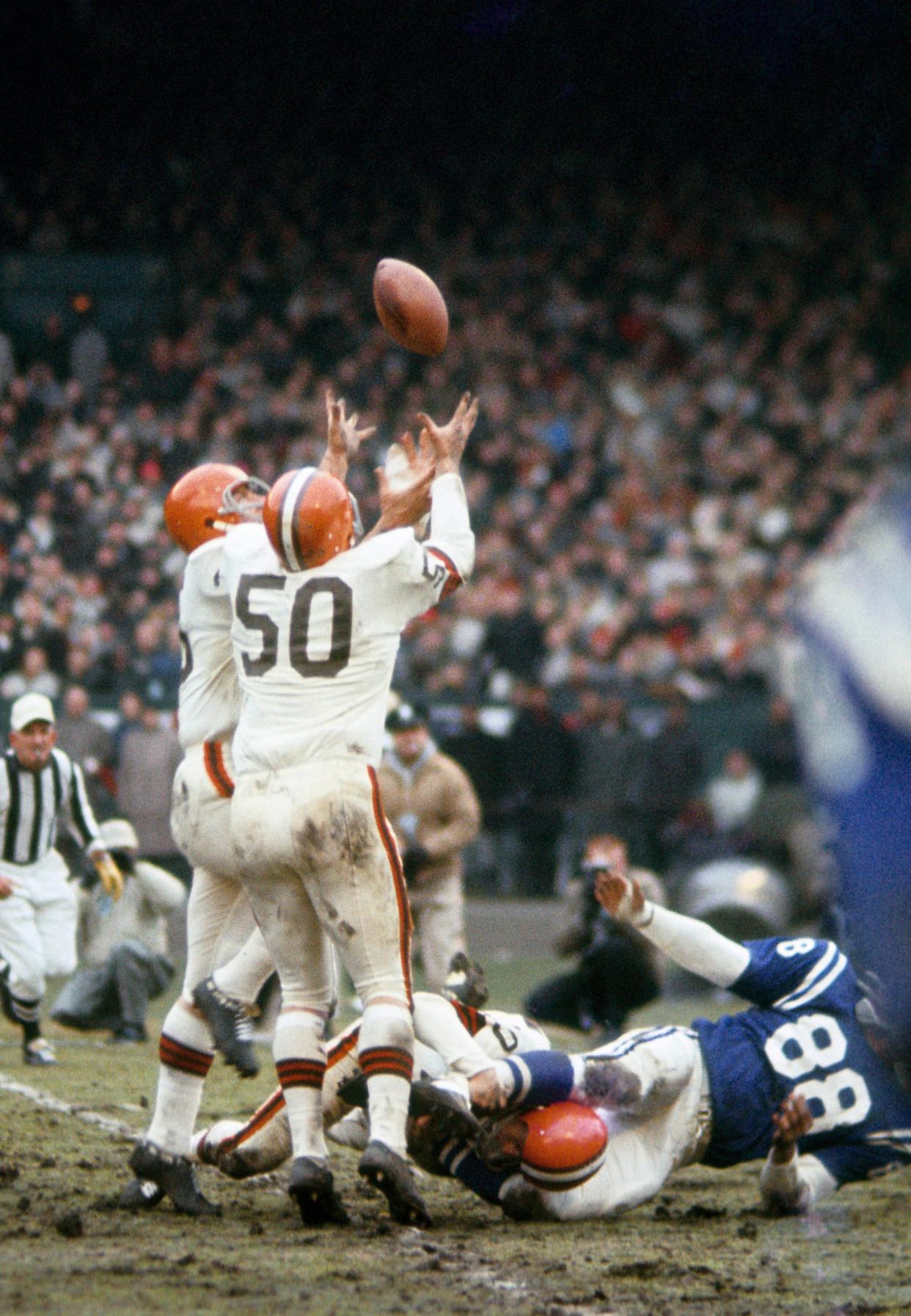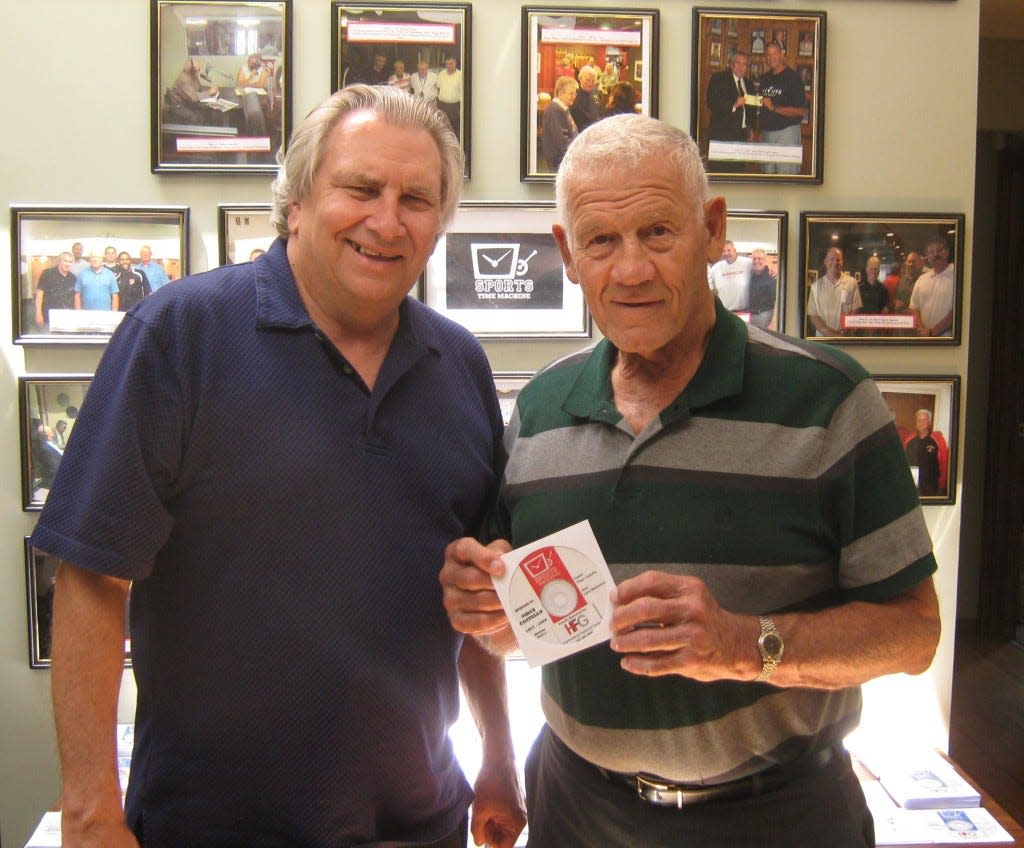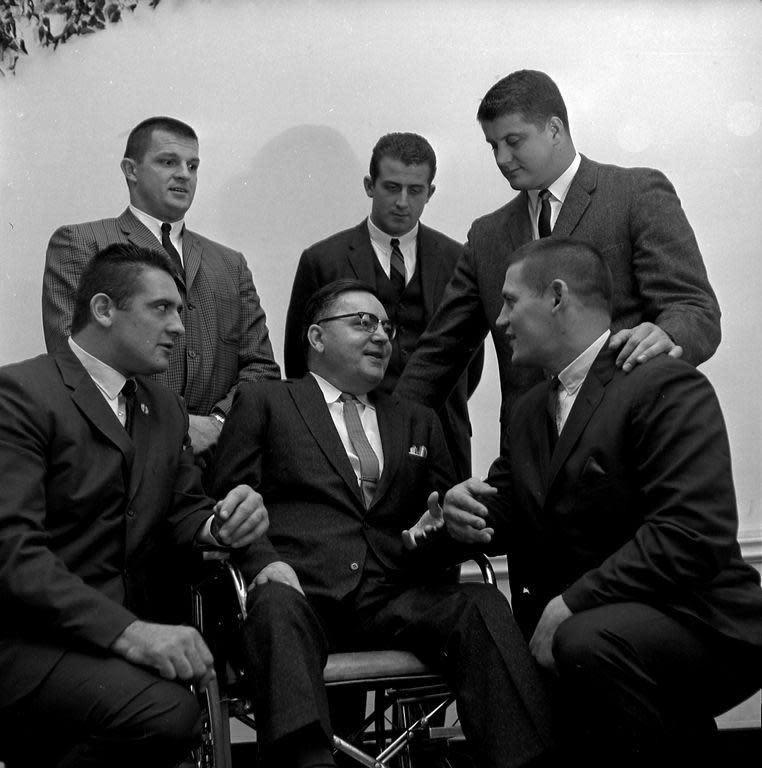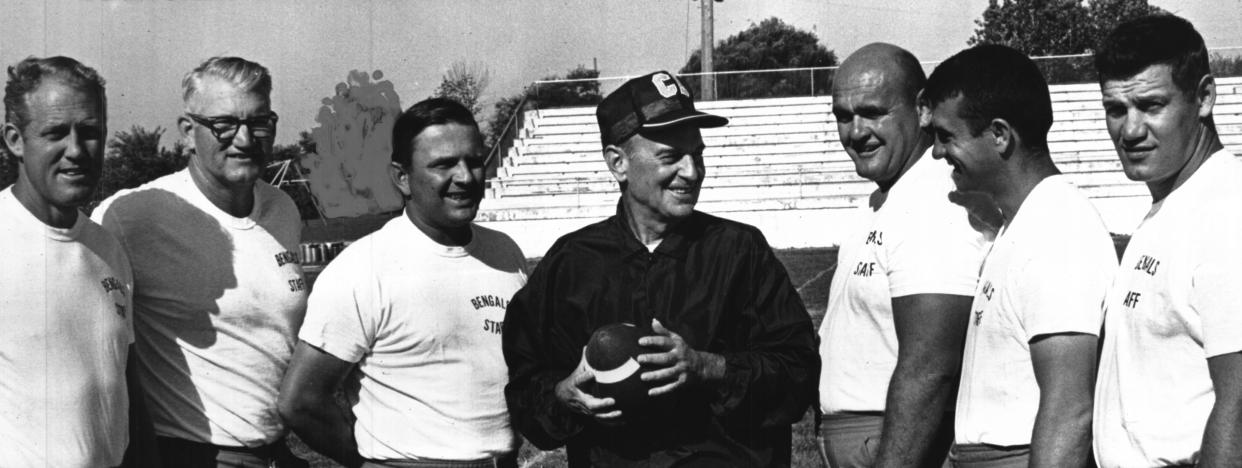Why 10-year Cleveland Browns linebacker Vince Costello is worth a dinner and 2 statues
"The Pride of Magnolia," Vince Costello, might laugh about the dinner in his honor being in Waynesburg.
Waynesburg was to Costello what the Steelers are to the Browns.
Before the 1954 Sandy Valley consolidation, the villages of Magnolia and Waynesburg had their own high schools.
Before Costello helped the Cleveland Browns win the 1964 NFL championship, he played basketball for the Magnolia Panthers. The Waynesburg Mighty Mohawks were a neighbor and a state power.
Waynesburg names — Trilli, Biggums, Serafini, Gervassi — stuck in his craw. He never forgot missing a layup late in a narrow loss to Waynesburg.
"I couldn't stand 'em," Costello said in 2011. "We never beat Waynesburg in basketball."

He took his Magnolia pride to Cleveland, starting at middle linebacker for 10 seasons. He intercepted Johnny Unitas in a 27-0 victory over the Baltimore Colts in the 1964 NFL title game — the Browns are still looking for their next league championship 60 years later.
He eventually settled in Kansas City, where he operated Vince Costello's Greenhouse restaurant. He loved coming home to Canton-area family and friends — including old rivals from Waynesburg — prior to his death in 2019.
The Magnolia Area Historical Society commissioned two steel statues of Costello, one of to be installed near his old football field (still in use), the other near baseball fields in town.
A dinner and program has been set for Tuesday, April 16, at Cibo's in Waynesburg. It is open to the public (call 330-866-9744 for tickets), with proceeds benefitting the Vince Costello Memorial Sports Complex.
Costello found fame at a fascinating time in Browns history. His road to the NFL is its own intriguing tale.
Bartolomeo Giordonno and Celesta Menna immigrated to the United States from Italy about 100 years ago. Bartolomeo "Americanized" his surname to Costello and married Celesta.
They settled in Magnolia and raised three daughters and three sons, including Vince.
They saw Magnolia's dirt roads paved as government work projects during the Great Depression. They kept the faith at St. Mary of the Immaculate Church.
Bartolomeo worked during World War II and beyond at Canton Drop Forge. Vince did heavy lifting at a local brickyard as a teen.
The war ended as Vince's freshman year at Magnolia began. He loved sports and hated that his school didn't offer football.
He and friends threatened to stay home if football wasn't added; it was, in time for his junior year, 1947.
Magnolia and schools from nearby counties competed in "six-man football." With Costello at quarterback, Magnolia went undefeated in 1947 and '48.
Six-man rules were odd. A favorite Costello play was taking the snap, handing the ball back to the center, and watching him run.
In basketball, Vince didn't miss many layups. Lou Venditti, a coach at East Sparta, helped arrange a basketball scholarship at Ohio University, whose head coach, Jim Snyder, was a Canton guy.
Costello's college basketball career lasted one season, during which he broke his nose and was still wearing a mask when baseball season began. Baseball and football became his sports throughout his Ohio U days.
Cincinnati signed him to a $3,000 pro contract in 1953. He had washed dishes to make ends meet and thought he was rich.
He was a first baseman for the Burlington (Iowa) Flints, managed by a famous ex-Reds pitcher, Johnny Vander Meer. He moved on to the Duluth (Minnesota) Dukes in 1954, before a military draft detoured him to the U.S. Air Force in 1955.
In 1956, he was back in baseball with the Wasau (Wisconsin) Lumberjacks, questioning his future with the Reds. Howard Brinker invited him back to football.
"Howard Brinker coached me on defense at Ohio U," Costello said. "He was defensive coordinator of the Browns, and I tried out.
"I was athletic. I had some quickness. I always thought I could make it."

(Costello's voice is preserved in archives of Larry Hackenberg's Sports Time Machine radio program; his quotes in this story come from there.)
Costello signed a $6,000 contract in 1957, contingent on making the team as a 25-year-old rookie.
"The first day at practice they put me at middle linebacker," he said. "My first game was in Akron."
The Rubber Bowl was jammed with 40,150 people when he faced the Lions in the preseason. There were three more Browns-Lions meetings in '57, a preseason rematch, a regular-season battle, and finally the 1957 NFL championship game.
Losing the title game left a hollow feeling that didn't go away until 1964. The Browns won but could have won more, he thought. They were 88-39-5 overall and 13-7 against Pittsburgh in his career.
He and Jim Brown both were rookies in 1957. The Hall of Fame back played nine seasons, all with Costello as a teammate.
"I covered him every day in practice," Costello said. "He was an upright runner who could accelerate like nobody ever has. In my view, he was the best player ever."
In his 1989 book "Out of Bounds," Brown lauded Costello as one the best players in the 1964 title game:
"He was a tough, undersized linebacker who had been there ever since I had, and Vince kicked some ass."
Art Modell bought the Browns in 1961 and, after the 1962 season, fired storied head coach Paul Brown.
"I always had a good relationship with Paul Brown," Costello said. "I never did like Art Modell as an owner. He might have been OK as a person.
"From day one Art Modell tried to come around and make friends with players. It was all kind of out of sync. I told them there was something wrong with that guy.

"My Browns career ended over a $500 disagreement. Modell came in one day after a (1967 preseason) game and asked when I was going to sign a contract. I said some nasty words to him and the next day I was gone."
"The Pride of Magnolia" was a source of celebration for Canton-area people who followed the Browns.
Ron Blackledge of Canton recalls riding with Costello's brother Tim to assorted games. Afterward they would find a Cleveland restaurant where Vince would hold court. It was good practice for when he opened Costello's Greenhouse.
"It was one of the best restaurants in Kansas City," Blackledge said. "Celebrities would go there. I met George Brett there once. Vince had the perfect personality to attract people to a restaurant or to anything else."
Costello relocated in 1967 and started every game for the New York Giants. Paul Brown was organizing an expansion team in Cincinnati that would debut in 1968.

Brown asked Costello to be an assistant coach. Costello wasn't ready to give up his linebacker salary. He was 36 when he played his last with the Giants. He joined the Bengals in 1969.
Costello's self-confidence was still on display when he was 76, speaking to the Hall of Fame Luncheon Club in 2008.
He considered himself "an X's and O's guy" with an understanding of what made a football player.
He thought Paul Brown should have played Bobby Mitchell at receiver, not running back, since Jim Brown was there. He thought Massillon's Jim Houston was a good linebacker who would have been a great defensive end.
"Vince was very cerebral," said Blackledge, a retired coach. "It seemed every year they wanted to replace him because he was 'too short' or 'not fast enough,' but he understood how to play football. They couldn't get him off the field."
After five years as a Bengals coach, Costello became Don Shula's defensive coordinator in Miami. When his former Browns road roommate Paul Wiggin became head coach of the Chiefs in 1975, Costello couldn't resist his old friend's plea to join him.
That began a decades-long residence in Kansas City. Magnolia never stopped being home.
The April 16 dinner at Cibo's is a prelude to a July 21 dedication of the statues. The tributes are overseen by the Historical Society, whose president is Janet Rogers — her husband and Costello were best men in each other's weddings.
Costello married a Massillon girl, Sally Dutton; they had seven children. Claudia Rogers, member of committee arranging the Costello tributes, said Sally, the children and some grandchildren, most of whom live in the Kansas City area, have committed to attend.
Reach Steve at steve.doerschuk@cantonrep.com
This article originally appeared on The Repository: Cleveland Browns 1964 legends Jim Brown, Vince Costello get statues
